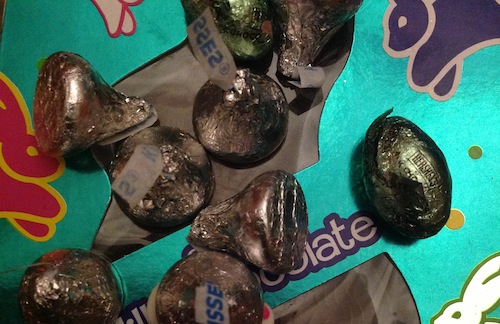Easter Sunday saw St Paul, Minnesota waking up to weather perfection. Sunshine, low seventies (Fahrenheit), cloudless sky. Truly amazing.
There was a loon on Lake Phalen!
This was the sort of April weather that brings Minnesotans out of their homes to rediscover their neighbors.
—
So it is with Griffin, Tabitha and me on this warm spring morning. We are enjoying the warm sunshine on our front steps when L (five year old girl), O (3 year old boy) and their mom come biking, biking and strolling (respectively) down the sidewalk.
L is on a neighborhood mission delivering handmade Easter greeting cards.
It turns out that she has also pocketed some goodies from her own Easter basket. While we chat, she pulls out a bag of Cadbury mini eggs. In case you are unfamiliar, these are the size of pebbles. They are chocolate inside with a crunchy candy shell. Like an oversized egg-shaped M&M. Each little bag contains about a dozen.
So. Much. Candy.
This is likely a small fraction of the candy L has consumed by the time she stops to chat.
Anyway, mom notices the bag as soon as it emerges from L’s pocket. (Side note—mom is across the street! Holy SuperMom powers!) She warns L not to eat any more of these; arguing that L has had enough candy for one morning.
L (5 years old): Please?
Mom: If you give everybody one, you can have one.
L proceeds to cheerfully open the package, hand one to Tabitha (who eagerly and gratefully receives it), one to Griffin and one to me.
I begin to think about what question to ask to get some math talk going.
But L is ahead of me.
After enjoying both her egg and a long thoughtful pause, she pokes her finger back into the bag. She begins to rummage around and asks:
L: Tabitha, do you want a second one?
So what do we learn?
Children use math to their advantage.
L knew what mom meant. Mom had compromised on the candy, allowing her one piece. L knew that. And she knew that the process was repeatable.
One does not always mean one. One might be taken to mean each. “Each time you give everybody one, you can have one.” This is also a reasonable interpretation of mom’s words.
L was rule bending here. But she was also building the precursors of ratios. For every one you give a friend, you can have one. This is a ratio. Giving a friend two and having two fits this rule just as well as giving a friend one and having one. Ratios are one of the more challenging ideas behind multiplication and division relationships, and fractions.
What is maddening for parents is at the same time great thinking practice for children.
Starting the conversation
This was a brilliant compromise strategy on mom’s part. I doubt that she intended to encourage L to think proportionally, but that doesn’t matter. More likely, she was trying to encourage the admirable social skill of sharing. By including numbers in her compromise, she opened the door for L to think.
As I have mentioned before, anytime your child wants to open a negotiation, there is an opportunity for math talk. Sometimes we parents need to give a flat out yes or no. But when negotiations are feasible, we can get our children thinking.

